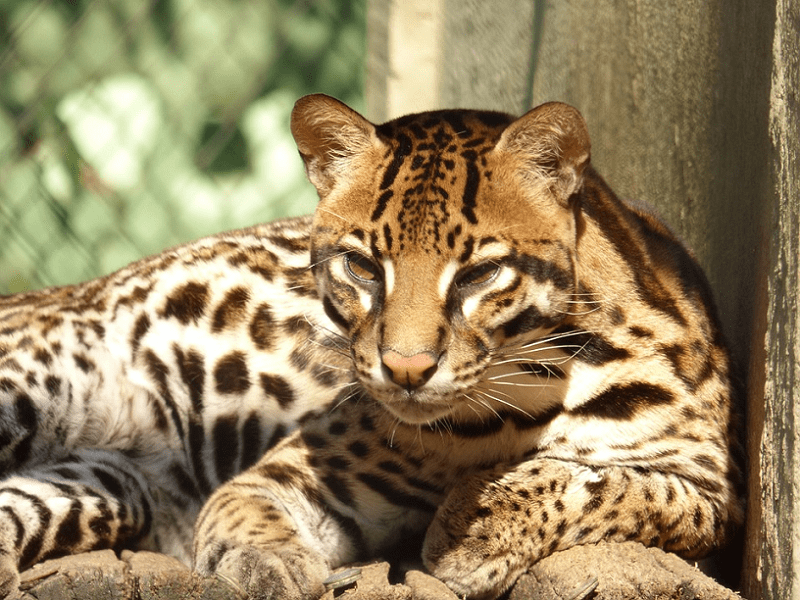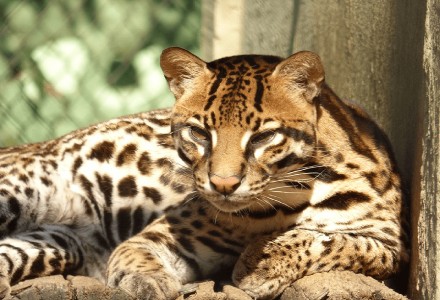
Ocelot Facts
- Perhaps most notably, the short term of Ocelot serves as the generally accepted common name of a truly stunning species of wildcat. Despite its size, however, the scientific name for the animal aptly points out its relationship with larger felines.
- That holds true due to the fact that this name remains the impressive, though difficult to pronounce, term of the Leopardus pardalis. The renowned Swedish zoologist Carl Linnaeus became the first person to officially describe the species, in 1758.
- Quite sadly, in the past, mankind widely hunted the animal for its pelt, which was regarded as highly valuable. Thankfully, due to a more enlightened government, this practice was banned decades ago throughout its endemic territory.
- Very fortunately, while most wildcats see their numbers dwindling rapidly, the beautiful Ocelot stands apart. That’s because the creature holds the distinction of being one of the few wild felines that the IUCN lists as a Species of Least Concern.
- Previously, the stunning feline held the status of Endangered, until the year 1996. But, thankfully, efforts at protecting the creature allowed its numbers to bounce back significantly. It now faces the potential threat posed by ongoing climate change.
Related Articles
Iberian Lynx Cougar Pallas Cat
Ocelot Physical Description
First of all, the remarkable Ocelot earns its attention for reasons other than sheer size. To be more precise, the beautiful feline qualifies as a moderate-sized variety of wildcat. The species also displays a comparatively moderate degree of sexual dimorphism.
Females of the species often weigh as much as 25 lb (11.3 kg). The males, meanwhile, reach a greater weight of as much as 34 lb (15 .5 kg). Both sexes this beautiful mammal additionally attain an average overall body length of between 22 – 39 in (55 – 100 cm).
That makes the magnificent species significantly smaller in size than most, but not all, wildcats. The moderately impressive tail, however, adds an additional 10 – 16 in (25.5 – 41 cm) to the total length of the feline. It also serves to add to its beauty.
In color, the fur of the gorgeous Ocelot displays predominantly a tawny yellow with numerous black markings. Additionally, the neck and belly typically display a white coloring. Meanwhile, its fur usually remains short on the belly but grows longer on the back.
But, its distinctiveness does not end there. Adding to its visual appeal, the small ears usually remain rounded. These also display a prominent white spot, creating a dramatic effect. The eyes most commonly show a brown color that reflects patterns of gold in bright light.
- Kingdom: Animalia
- Phylum: Chordata
- Class: Mammalia
- Order: Carnivora
- Family: Felidae
- Genus: Leopardus
- Species: L. paradis
Photographer: João Carlos Medau
CC License: https://bit.ly/1ryPA8o
Ocelot Distribution, Habitat, and Ecology
Most notably, the actual range of the amazing Ocelot covers an extensive region of the globe. More precisely, this zone of habitation extends through portions of the United States, in North America, through Mexico and much of Central America and South America.
But, population densities for the creature also vary somewhat widely throughout its range. However, the highest known density occurring in Panama. In all areas, though, this particular animal inhabits an impressively wide range of habitats.
This flexibility contributed to its numbers rebounding from a few decades ago. These habitat types include such regions as rainforests, scrublands, mangrove forests, and even coastal marshes. It prefers lower elevations, but some occur as high as 9,843 ft (3,000 m).
Like all wildcats, the breathtaking Ocelot also evolved to have an entirely carnivorous diet. Given its habitat range, and its size, its primary prey consists of smaller creatures. Thankfully, however, its native range continues to have an abundance of these.
These include such species as rabbits, rodents, fish, birds, opossums, armadillos, and occasionally small reptiles and even insects. Finally, hunting typically occurs during the evening and at night, but sometimes happens during the day when necessary.
Species Sharing Its Range
Goliath Birdeater Doll’s Eye Goldsmith Beetle
Check out our other articles on 5 Rare Mind-Blowing Cloud Types, Spotted Handfish, Eye of the Sahara, White Witch Moth, Inaccessible Island Rail, Chatham Island forget-me-not

